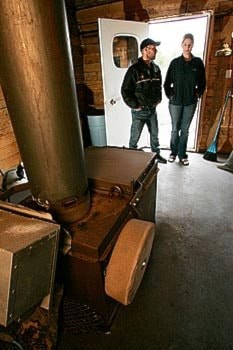In a land of ice, snow and permafrost, the delicate task of burying deceased pets has always posed a problem.
For any cat or dog with the audacity to die in December, valuable freezer space can be taken up for months while waiting for the ground to thaw.
And it’s not a good idea to throw them in the dump. Toxic chemicals resulting from a lethal injection can have harmful environmental impacts if wild wolves or ravens eat the corpse.
In the late 1990s, Elijah Smith Elementary School teacher Pete Harms read a newspaper article about the growing business of pet crematoriums and an idea was hatched.
If you can’t bury them — cremate them.
A few phone calls and internet searches later, Quiet Waters pet crematorium was born, situated in the front yard of Harms’ 16-hectare property near Lake Laberge.
Whitehorse’s first and only pet crematorium, Quiet Waters was also an ideal employment scheme for his four children.
“We’re a family of four. Four kids. We’re all pet owners and pet lovers so we definitely all took a part in the business,” said Jodi Giesbrecht, Harm’s oldest daughter, who was 14 when the crematorium was built.
Growing up with a pet crematorium in the front yard made childhood very unorthodox for the young Jodi.
“As kids, you’re not really used to death … it takes a long time. Not that it becomes any easier, but you realize that it’s a fact of life and animals, unfortunately, don’t last forever,” said Jodi.
“Unless you own a parrot or a turtle,” she said.
But the pet crematorium quickly filled an essential niche within the Yukon.
“People were relieved that there was an alternative option. If you had an older pet, you often had to put it down in the fall, just so you could bury it — you didn’t always want your animals to have to make it through a winter,” said Jodi.
Now, after 10 years, Quiet Waters is being passed onto the next generation of Harms.
Just recently, Jodi and husband Russ Giesbrecht took the business over from Jodi’s parents.
Having married into the unusual realm of pet cremation, Russ, a ferrier by trade, has quickly embraced the Harms family’s signature business.
During my tour of Quiet Waters, it is often Russ doing the technical talk: how long to burn, at what temperature, and how to check.
He has proudly taken up the trade, yet among friends the issue of Quiet Waters usually stays unspoken.
“It’s not something we really discuss with our high school friends,” said Jodi.
When people do find out, they’re often “amused” or sometimes, they’re “disgusted at the thought of someone doing it for a business” said Jodi.
“Somebody has to do it,” said Russ.
At the front of the Harms’ property lies an unassuming cabin, located adjacent to a large horse paddock.
Two young midsize dogs run friskily around the property, occasionally nipping at each other’s noses.
Inside the cabin, which is almost sauna-hot, lies a small concrete box labelled with the brand name “Burn Easy.”
Tasteful oil paintings decorate the bare log walls, and a pile of old towels and plastic totes sit haphazardly stacked in a corner of the cabin — a pile of makeshift pet coffins.
Behind the cabin sits the larger burn unit, a massive cylinder used for larger animals (“Great Danes can be really tricky”) and mass cremations of animals picked up from the veterinarian.
Over the years, the couple has inevitably become self-taught funeral directors — especially on specific occasions when they must make house calls at all hours to pick up just-deceased pets.
“Being a longtime pet owner I have lost animals myself. When your deal with people — they’re crying and it’s hard for them, but you know exactly how they feel,” said Jodi.
Pets have special meaning to many Yukon residents, said Jodi.
“So many people don’t have family here, and that is their family. It’s almost different to think of it that way, but with some people their pets are really their very best friends,” said Russ.
“People up here are very outdoorsy, the dog is with you everywhere you go, so when you lose that, it’s important that it’s taken care of properly,” said Jodi.
Quiet Waters receives much of its business from euthanized pets being brought in from veterinarians, although they also conduct individual cremations.
Often, if a pet is from out of town, it will be frozen, wrapped in towels, placed in a box and shipped by courier to their facility.
And as with any business, pet crematoriums also undergo cycles of activity and inactivity.
Even though they are usually guaranteed a steady stream of deceased pets, the early summer months are always slow.
“People don’t want to put their pets down in the summer because they want them to be around just a little longer,” said Jodi.
In the case of individual cremations, families will be presented the ashes in either a disposable container, or in a handmade pine box.
“A lot of people will decide to bury the ashes, but with a lot of them, it just gives them time to decide what to do,” said Russ.
While Russ and Jodi list off the species of animals that have been cremated at Quiet Waters, it sounds almost like the passenger listing for Noah’s Ark: cats, dogs, ferrets, rabbits, hamsters, a horse foal and even a baby muskox from a nearby game farm.
For mass cremations, Russ or Jodi simply scatter the ashes in the surrounding poplar woods — woods that no doubt now hold the ashen remains of thousands of deceased pets.
